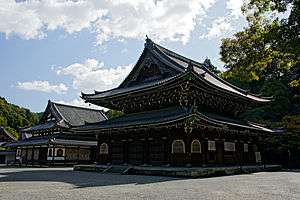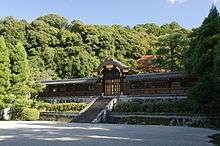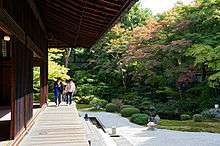Sennyū-ji

Sennyū-ji (泉涌寺),[1] formerly written as Sen-yū-ji (仙遊寺),[2] is a Buddhist temple in Higashiyama-ku in Kyoto, Japan.[3] For centuries, Sennyū-ji was a mortuary temple for aristocrats and the imperial house. Located here are the official tombs of Emperor Shijō[4] and many of the emperors who came after him.[2]
History
Sennyū-ji was founded in the early Heian period.[2] According to one tradition, it was founded as Senyū-ji (仙遊寺) in 855 at the former mountain villa of Fujiwara no Otsugu.[5] According to another tradition, this temple was a reconstruction of an earlier temple, Hōrin-ji (法輪寺), which had been founded by Kōbō-Daishi in the Tenchō era (824-834).[3] The major buildings in Sennyū-ji were reconstructed and enlarged in the early 13th century by the monk Shunjō.[5]


Tsukinowa no misasagi
Emperor Go-Horikawa and Emperor Shijō were the first to be enshrined in an Imperial mausoleum at Sennyū-ji. It was called Tsukinowa no misasagi.[4][6]
Go-Momozono is also enshrined in Tsukinowa no misasagi along with his immediate Imperial predecessors since Emperor Go-Mizunoo -- Meishō, Go-Kōmyō, Go-Sai, Reigen, Higashiyama, Nakamikado, Sakuramachi, Momozono and Go-Sakuramachi.[7]
Nochi no Tsukinowa no Higashiyama no misasagi
Kokaku, Ninko, and Komei are also enshrined at Nochi no Tsukinowa no Higashiyama no misasagi (後月輪東山陵).[7][6]
Art
Sennyū-ji's large nehan-zu painting depicts Buddha on his death bed. This massive image (8 meters x 16 meters) is the largest in Japan. The image at nearby Tōfuku-ji is the second largest of its kind in Japan, measuring 7 meters x 14 meters. Both images are only rarely displayed, most recently in 2003 for three days only.[8]
See also
- Tsuki no wa no misasagi
- Tōfuku-ji
- List of Buddhist temples in Kyoto
- Thirteen Buddhist Sites of Kyoto
- List of National Treasures of Japan (ancient documents)
- For an explanation of terms concerning Japanese Buddhism, Japanese Buddhist art, and Japanese Buddhist temple architecture, see the Glossary of Japanese Buddhism.
Notes
- ↑ A guide to the Sennyū-ji Temple 1972.
- 1 2 3 Ponsonby-Fane 1956, p. 113.
- 1 2 "Sennyu-ji". www.buddhistravel.com. Archived from the original on 2011-07-08.
- 1 2 Ponsonby-Fane 1959, p. 422.
- 1 2 "概略" [Overview] (in Japanese). Sennyū-ji. Retrieved 8 December 2017.
- 1 2 "Sennyu-ji Temple, Kyoto". www.taleofgenji.org.
- 1 2 Ponsonby-Fane 1959, p. 423.
- ↑ "Kansai: Who -- What: Giant Buddhas shown for three days only," Japan Times Online. March 9, 2003.
References
- Hall, John Whitney, ed. (1988). The Cambridge History of Japan: Early modern Japan. Cambridge: Cambridge University Press. ISBN 978-0-521-22355-3. OCLC 17483588.
- Ponsonby-Fane, Richard Arthur Brabazon (1956). Kyoto: The Old Capital of Japan, 794-1869. Kyoto: Ponsonby Memorial Society. OCLC 182637732.
- Ponsonby-Fane, Richard Arthur Brabazon (1959). The Imperial House of Japan. Kyoto: Ponsonby Memorial Society. OCLC 277269606.
- 京都御寺泉涌寺展 [A guide to the Sennyū-ji Temple] (in Japanese). Kyoto: Asahi Shinbun. 1972.
External links
| Wikimedia Commons has media related to Sennyuji. |
- Senyū-ji website (in Japanese)
Coordinates: 34°58′41″N 135°46′50″E / 34.97806°N 135.78056°E